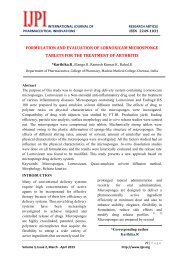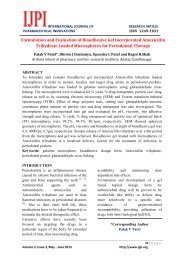WURSTER COATING- PROCESS AND PRODUCT VARIABLES - IJPI
WURSTER COATING- PROCESS AND PRODUCT VARIABLES - IJPI
WURSTER COATING- PROCESS AND PRODUCT VARIABLES - IJPI
You also want an ePaper? Increase the reach of your titles
YUMPU automatically turns print PDFs into web optimized ePapers that Google loves.
INTERNATIONAL JOURNAL OFREVIEW ARTICLEPHARMACEUTICAL INNOVATIONS ISSN 2249-1031pellets was rough and porous due to spraydrying effect. To cover these pores one hasto apply more coating.Particle size: As the particle sizedecreases the amount of coating materialrequire for desire thickness becomes veryhigh. The quantity of liquid also increasesas a result of decrease in particle sizebecause coating substance must be appliedusing some medium which is solidconcentrations in liquid in range of 10 to30%. Further complication is that as theparticle size decreases agglomerationbecomes more dependent on theformulation of the coating liquid andnozzle which is unavoidable. So itsuggested to use large particle size thatmay reasonably produce the desired results[6] .Product temperature: Specification ofproduct temperature will depend upon theglass transition temperature of polymer. Toget maximum efficiency it is we have tokeep product temperature as low aspossible. Lower the product temperaturelesser will be the static charge generationbut for some polymer like HPMC we haveto maintain high temperature to minimisethe agglomeration by drying the filmeffectively [1, 7] .Solution Viscosity and SolutionConcentration: We have to optimise theseparameters to have better control on theprocess. We have to reduce the spray rateif the solution is viscous and tacky. It isgenerally known that, higher solid contentwill reduce the process time. But it isopposite in case of polymers like HPMCand ethyl cellulose when they are insolution form. As we increase the solidcontent beyond certain limit for theseVolume 2, Issue 2, March− April 2012polymers, the spray rate will reduceradically, which results in higher processtime [2, 6] .Bulk Density of Finished Product: Onceit was thought it is uncontrollable propertybut research has shown that byconcentrating on two variables it can bereduced or altered. These factors are the inprocess moisture and the fluidizing airvolume. The lowest possible finishedproduct bulk density can be achieved bykeeping the bed moisture at or below themaximum finished product moistureduring spraying. In this way drying stage(which can cause product attrition andincreased bulk density) is not needed afterspraying. Volume of fluidizing air can beaffected by several factors. As the outer airfilter or the product bowl screen becomesoccluded by binder, by coating material, orby fine powders resistance to air flowincreases. Without a warning indicator thevolume of air can drop enough to cause thebed moisture to increase thereforeincreasing the bulk density of finishedproduct [1, 6] .References1. Jones David M. Factors to Consider inFluid Bed Processing. PharmaceuticalTechnology.April 1985.2. Dr. Mehta Atul M. Scale upConsiderations in the Fluid BedProcess for Controlled ReleaseProduct. Pharmaceutical Technology.Feb. 1988.3. Lachman Leon, Lieberman Herbert A.Kanig Joseph L.The Theory andPractice of Industrial Pharmacy. 3rd ed.Bombay: Varghese publishinghouse.1987:419 - 420.65 | P a g ehttp://www.ijpi.org
















